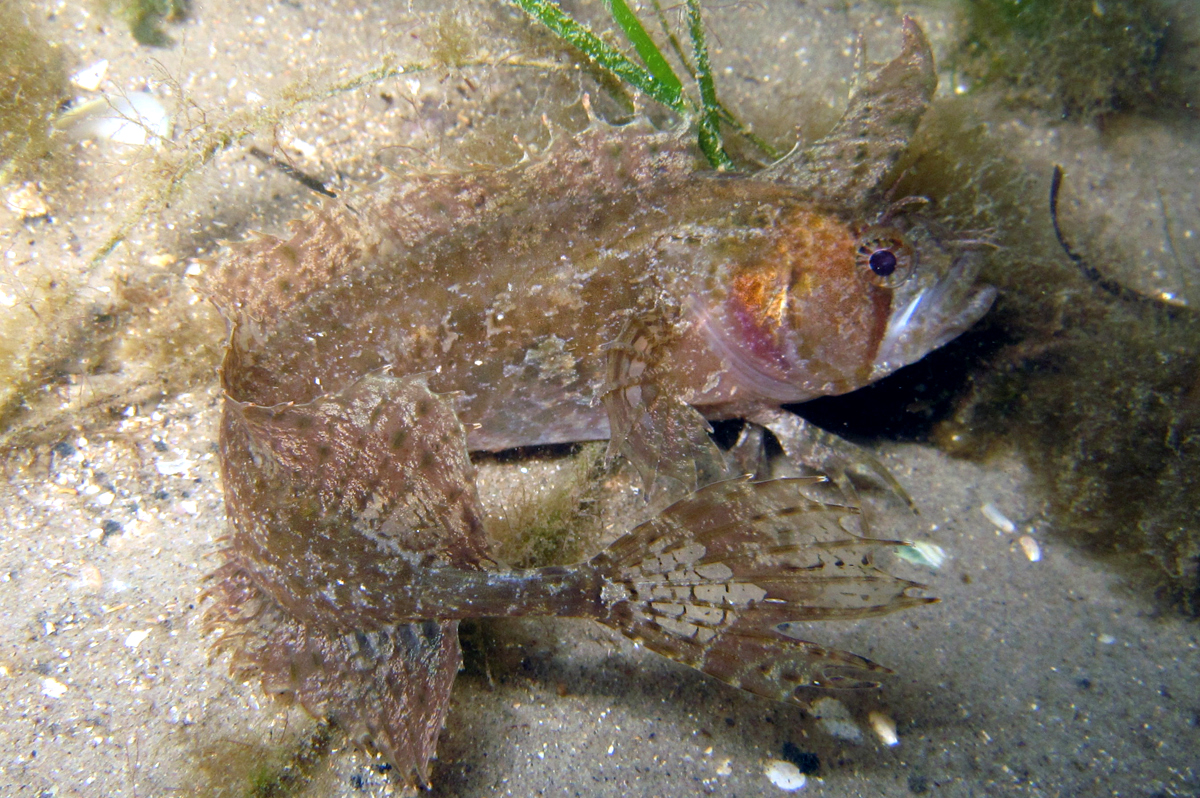Southern Crested Weedfish, Cristiceps australis Valenciennes 1836

A Southern Crested Weedfish, Cristiceps australis, at Jawbone Marine Reserve, Port Phillip, Victoria, March 2010. Source: Sarah Speight / Flickr. License: CC by Attribution-NonCommercial-ShareAlike
A variably coloured brown to yellow or green weedfish, either plain or with large pale blotches on the fins, and a distinct dark oblique bar with a silver leading edge from the eye to the rear of the mouth. The first dorsal fin is not connected to the long-based second dorsal fin. The Southern Crested Weedfish has a simple, long, pointed orbital tentacle, that is about equal in length to the eye diameter. The nasal tentacle is elongate with two simple slender lobes.
Southern Crested Weedfish are well-camouflaged amongst macroalgae and seagrasses, and vary widely in in colour.
Southern Crested Weedfish, Cristiceps australis Valenciennes 1836
More Info
|
Distribution |
Endemic to the southern half of Australia, from about Port Macquarie, New South Wales, to the Houtman Abrolhos, Western Australia, including Tasmania. Inhabits macroalgae on rocky reefs and seagrass beds in bays and estuaries, subtidally to 30 m. Juveniles are common in seagrass beds, or may shelter amongst detached algae and seagrass leaves. |
|
Features |
Dorsal fin III, XXVII-XXIX, 6-8; Anal fin II, 24-26; Caudal fin (segmented rays) 9-11; Pectoral fin 10-11; Pelvic fin I, 3; Lateral line (arched) 14-21 + (straight) 32-34; Gill rakers 1-2 + 5-7 = 8-9; Vertebrae (precaudal) 14. Body long, slender, strongly compressed, tail base very narrow; head length 27-29% SL; eye diameter 4-6% SL; snout length about equal to eye diameter, 5-6% SL; mouth reaching to below middle of eye in juveniles, to well behind eye in adults, length 11-14% SL. Orbital tentacle simple, elongated and pointed, about equal in length to eye diameter, 4-5% SL. Dorsal fin in two parts, the first tall, short-based, arising above middle of eye, rarely just in front of orbital tentacle, 2nd spine length 11-15% SL, not connected to the long-based second dorsal fin. Second dorsal-fin origin origin above posterior half of operculum, hind membrane of second dorsal fin connected to middle of tail base, skin flaps with free tips extending posteriorly from fin spines, posterior fin rays elongated, fin tips extending to caudal fin in adults. Pelvic fins with a tiny spine and three rays, tip of fin reaching to or just before anus, innner fin ray less than half length of 2nd ray.. |
|
Size |
To a maximum total length of 30 cm. |
|
Colour |
Reddish-brown, brown, or green, sometimes with scattered small brown spots; dark brown oblique narrow bar, often with silver leading edge, from underside of eye to just past rear end of jaws; side often with 5-6 faint narrow vertical brown bands onto dorsal and anal fins; usually with series of small silver or white spots along or just below midside; front of 1st dorsal fin dark brown to black; 2nd dorsal and anal fins mottled, forming irregular horizontal stripes, or with broad brown vertical bands and clear interspaces; tip of 2nd dorsal fin white; small dark brown spot basally in middle of dark band on 2nd dorsal fin and sometimes anal fin; pectoral, pelvic and caudal fins mottled with irregular bands or dark brown with clear or white areas. |
|
Feeding |
Feeds on small fishes and crustaceans. |
|
Etymology |
The specific name is from the Latin australis (= southern) in reference to the southern Australian distribution of this species. |
|
Species Citation |
Cristiceps australis Valenciennes, in Cuvier & Valenciennes 1836 Hist. Nat. Poiss. 11: 336. Type locality: upper Derwent River, Tasmania. |
|
Author |
Bray, D.J. & Gomon, M.F. 2022 |
|
Resources |






